When I last shared my Toyota Prius project with you, it had received some wheels and lowering springs and since then has been a blast to drive, but I am on the path of adapting OEM Toyota parts wherever possible and attempting to drop some weight from the car. Our latest test digs into both.
Installing new wheels with Michelin all-season tires was probably the largest improvement from a handling perspective, but it also came at a slight cost on the efficiency side due to the wider contact patch. One of the reasons that the Toyota Prius Prime is so efficient is the fact that every piece of the car is engineered for the task at hand, which means that the OEM 17×6.5 wheel and 195/60R17 Bridgestone Ecopia tire only weigh in at 36.5 pounds per corner, and even though I found forged 19-inch wheels as replacements, the added width of the wheel plus the added rubber of the wider tire meant that I increased the weight to 47.5 pounds per corner. This was a reasonable compromise for me, as the handling was still significantly better than stock, but I saw an efficiency drop and knew that handling could be further improved with lighter wheels.
New Wheels and Tires
I lucked out and found a set of take-off wheels from a Mitsubishi Lancer Evolution on eBay and decided to match them with a set of the new Michelin Pilot Sport 5 tires. The Evo wheels are an inch wider than the Lexus wheels but are only 18-inches in diameter, and combined with the efficient build of the new Pilot Sport 5 tire, that meant I was able to drop down to 42 pounds per corner compared to the Lexus wheels, potentially improving handling not only from a weight perspective and also from a tire compound/construction perspective.
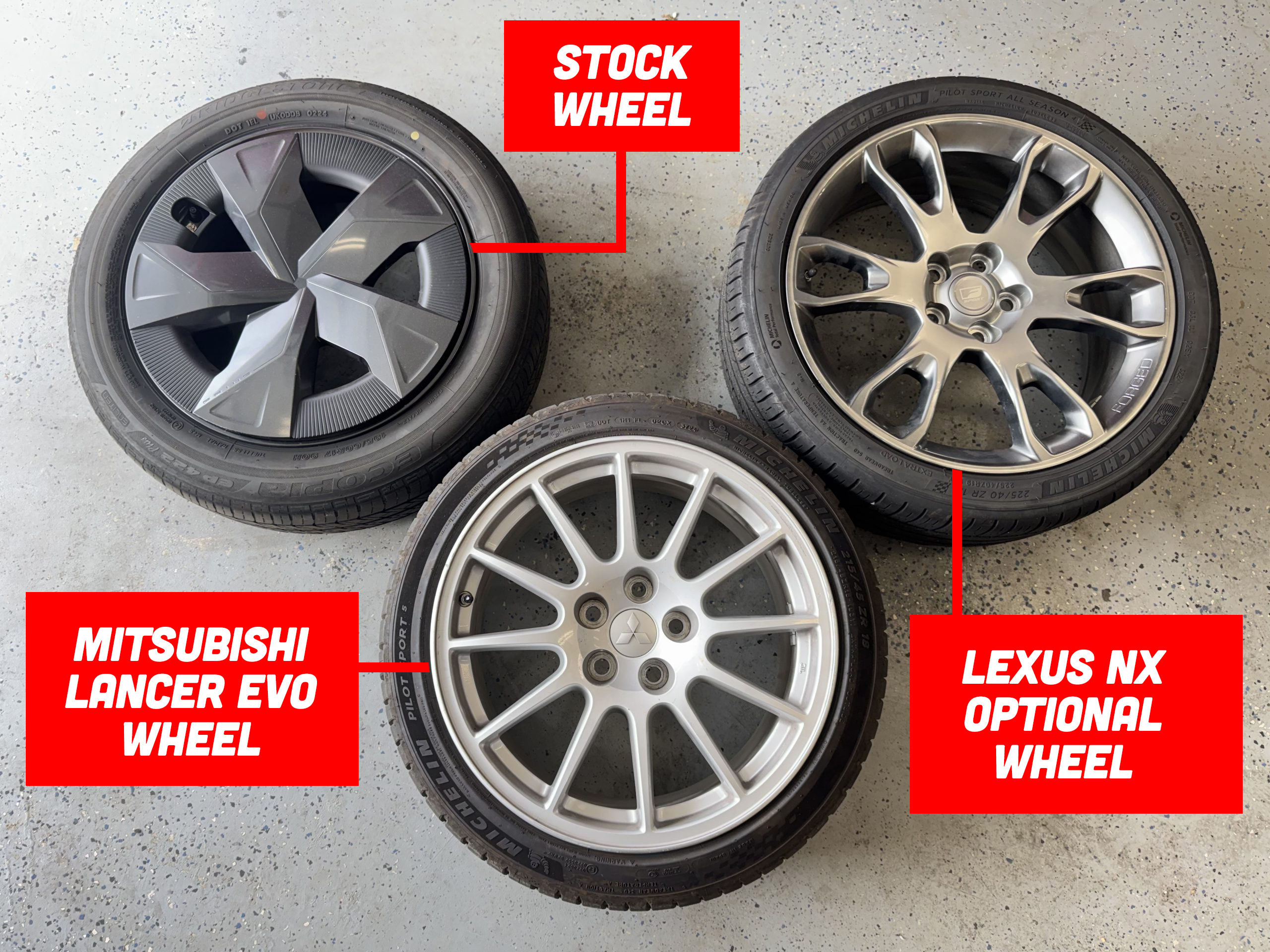
The handling improvement from the Michelin PS5s isn’t a surprise as they are summer tires, but they also implement a lot of tech from the brand’s most extreme performance tires and borrow their “Wavy Summit” construction from Sport Cup 2 tire. The name of the architecture comes from the fact that there is a wavy layer of rubber in the plies underneath the structural cables in the tire, theoretically improving cornering and steering response due to increased stiffness.
Testing Brake Upgrades
Moving to a new wheel and tire also opened opportunities to chase another project because the spoke design of the Evo wheels allowed for a larger brake caliper to fit on the front. I had previously acquired a set of GR Corolla 4-piston calipers but put the project on hold after doing some measurements and realizing that the spokes of the previous wheel did not have enough clearance to the face of the caliper. Another stumbling block that came up was the fact that the GR Corolla uses a larger rotor which would mean more weight added to each corner. Fortunately, I learned that Toyota had combined the GR Corolla caliper with a smaller bracket that matches the Prius rotor already and used it on the JDM GR Yaris RC in order to fit a more rally suited wheel.
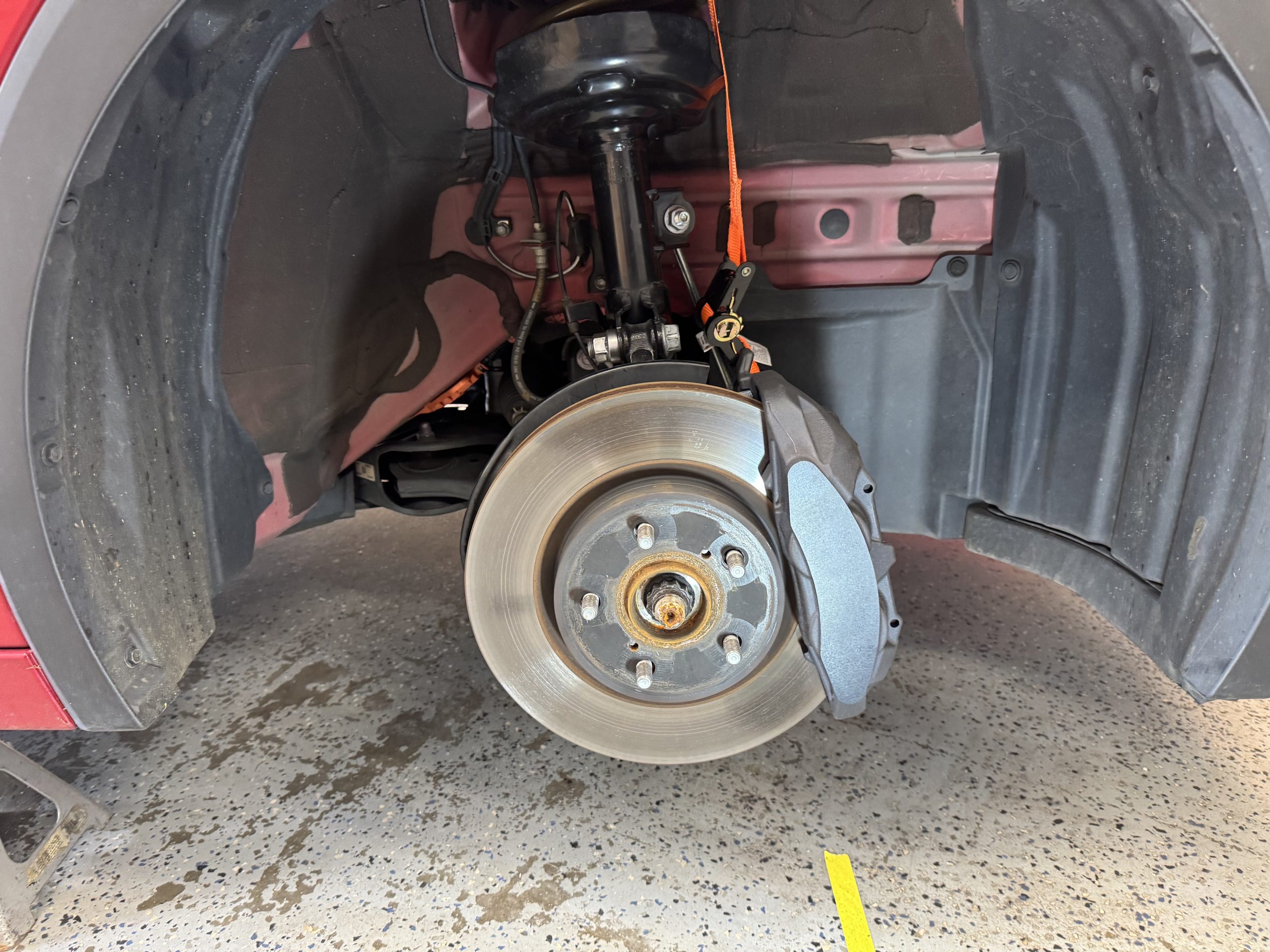
I ordered bracket part number 47751-52020 from Japan and it bolted right up to the caliper and the knuckle on the Prius as expected. The big benefit here is that the GR Corolla caliper is four pounds lighter than the single piston stock caliper on the Prius which should not only improve braking performance but also help with handling. Standard GR Corolla brake pads don’t fit this combination due to how close they are to the rotor hat so I’ll be working with Carbotech to see if they can build me a customized version of the GR Corolla brake pads for the application.
More Suspension Upgrades
Lowering springs gave me a slight improvement in handling due to an increase in spring rate, but I was still convinced I should level up the entire suspension, so I decided to grab some components from a GR Corolla on eBay.
I was able to find a complete right front strut assembly with the knuckle and hub for a very reasonable price, allowing me to measure and test. Right out of the box, I was pleasantly surprised to see that the components were visually similar except for a few small details. The stud spacing on the top mount was exactly the same, and the plate looked to be similar as well, with the primary difference being the shape below, which wouldn’t impact how it mounts to the car. As shown by measurements in the video above, the flanges that mount to the knuckle also had the same spacing and even used the same nuts and bolts for the mounting, which gave me confidence for my test fit.
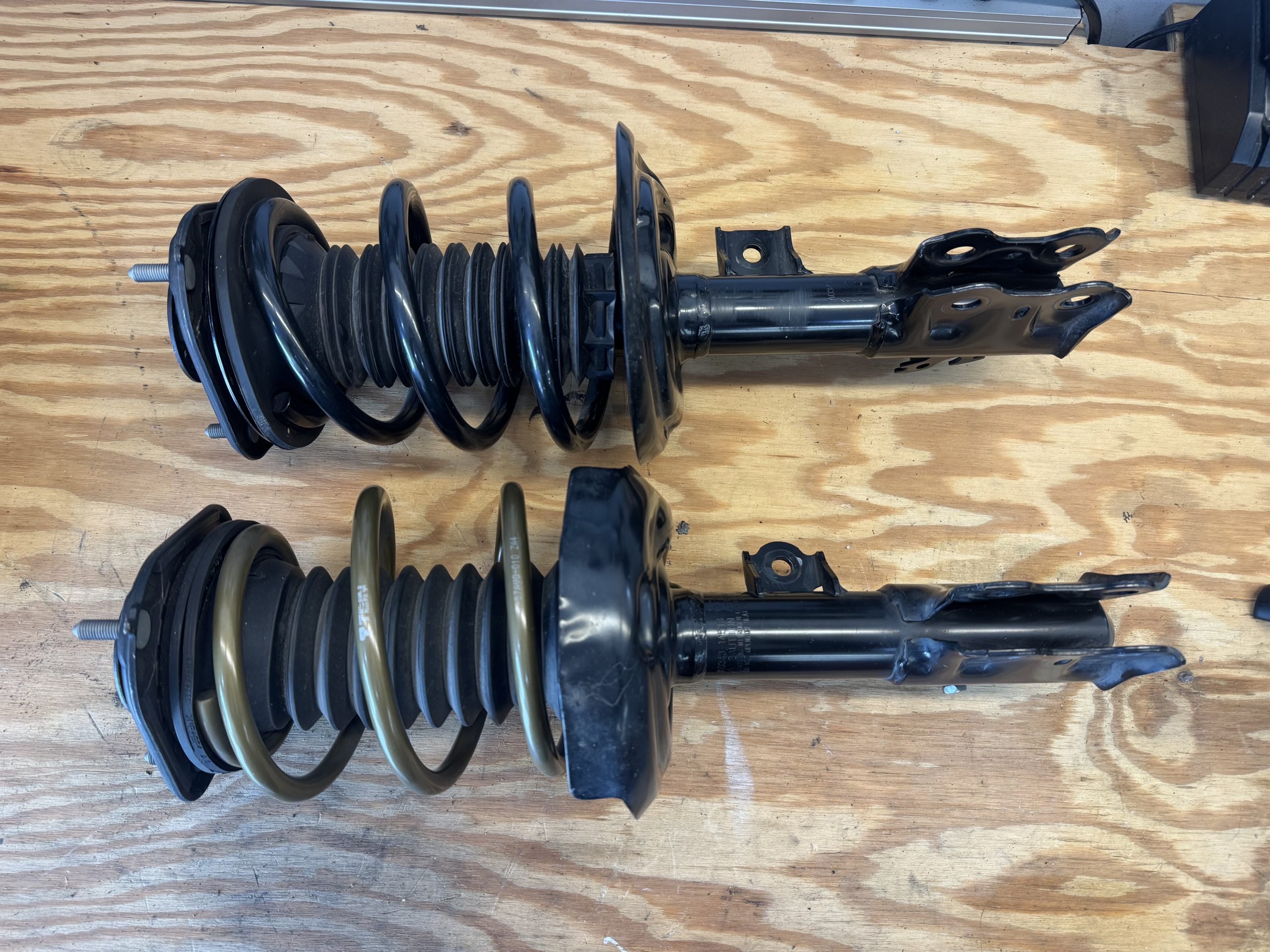
Installing the GR Corolla strut assembly was no different than installing the Prius strut assembly, as everything bolted up easily, and even things like brake line and speed sensor mounts were in the same position. One of the notable differences was that the anti-roll bar link mounts slightly farther away from the strut body, but attaching it did not cause any issues. I’ll do some math there to see if I need to make changes and swap to GR Corolla links if necessary.
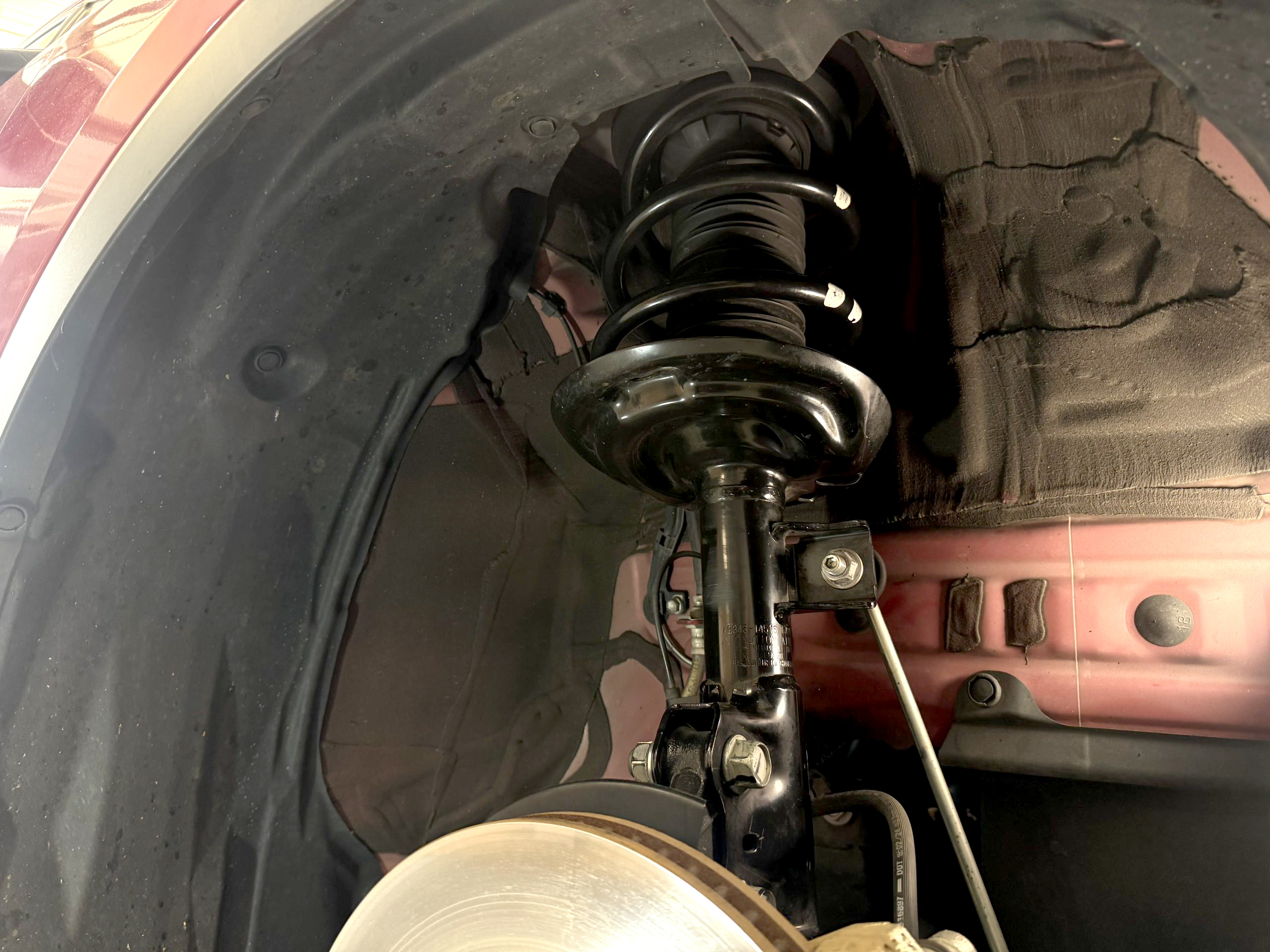
Now that I have confirmed fitment, my next move will be to make use of the GR Performance struts and shocks from Toyota that are intended for the GR Corolla; deciding on springs will be a tougher question. From my testing, using the OEM GR Corolla springs would increase my ride height back to where the Prius was from the factory, and I prefer the look and handling of the lowered car. The Tein lowering springs currently on the car have a spring rate of 145 lbf/in for the front and 200 lbf/in for the rear. OEM GR Corolla springs are rated at 285 lbf/in in the front and 340 lbf/in for the rear.
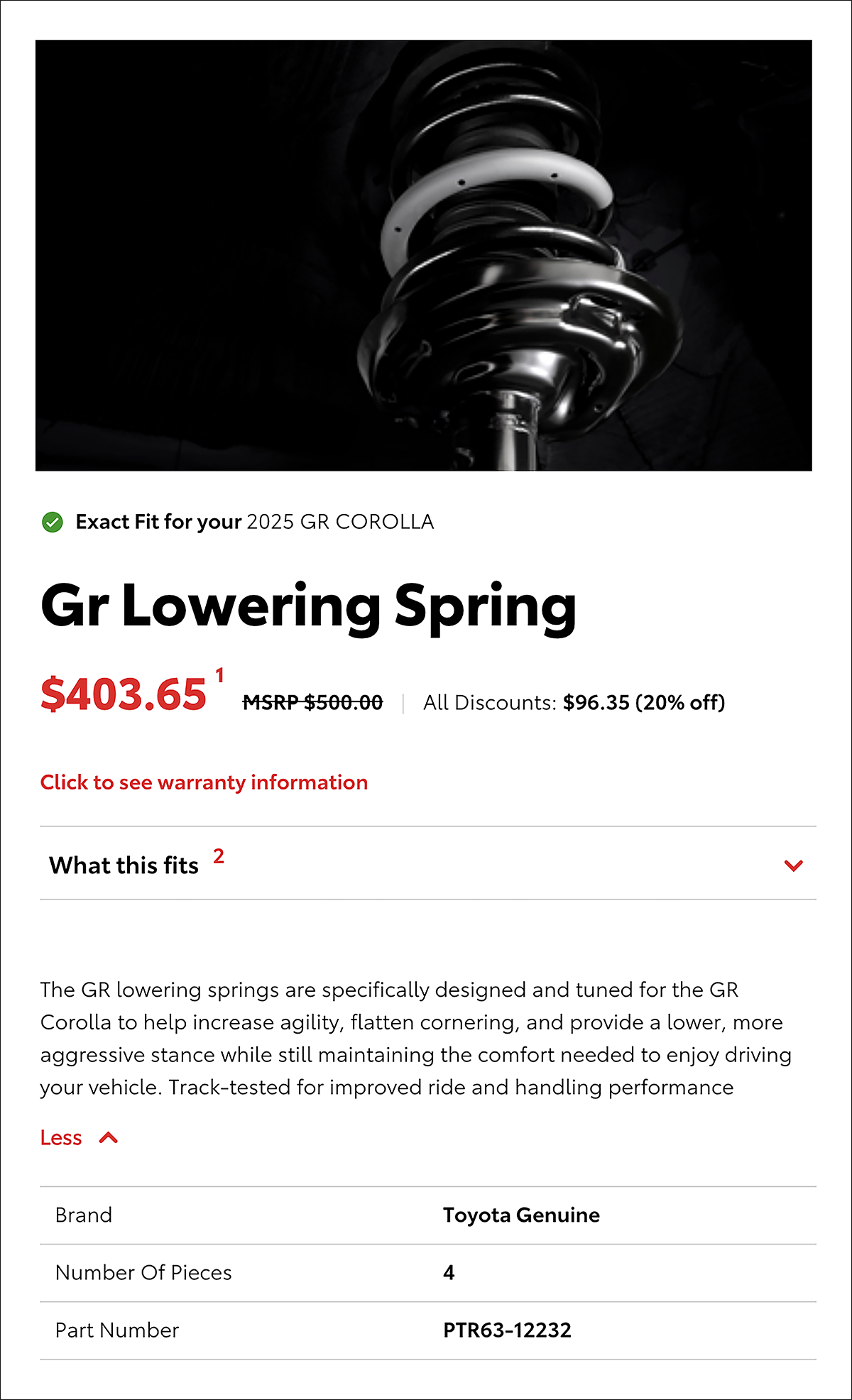
Toyota offers a GR Performance lowering spring kit under part number PTR63-12232 that is listed as matching the GR Performance shocks and struts, but no spring rates are listed, and GR Corolla owners have reported a drop of around an inch or so, which would be slightly higher than my current combination. The other option would be to chase aftermarket springs; something like RS-R SUS Down springs would offer a drop just over an inch with a spring rate of 340 lbf/in for the front and 400 lbf/in for the rear. I will likely start with the GR springs, since they are tuned for that strut and shock set, and then if I don’t like the ride height, I may chase some aftermarket options.
More to come!

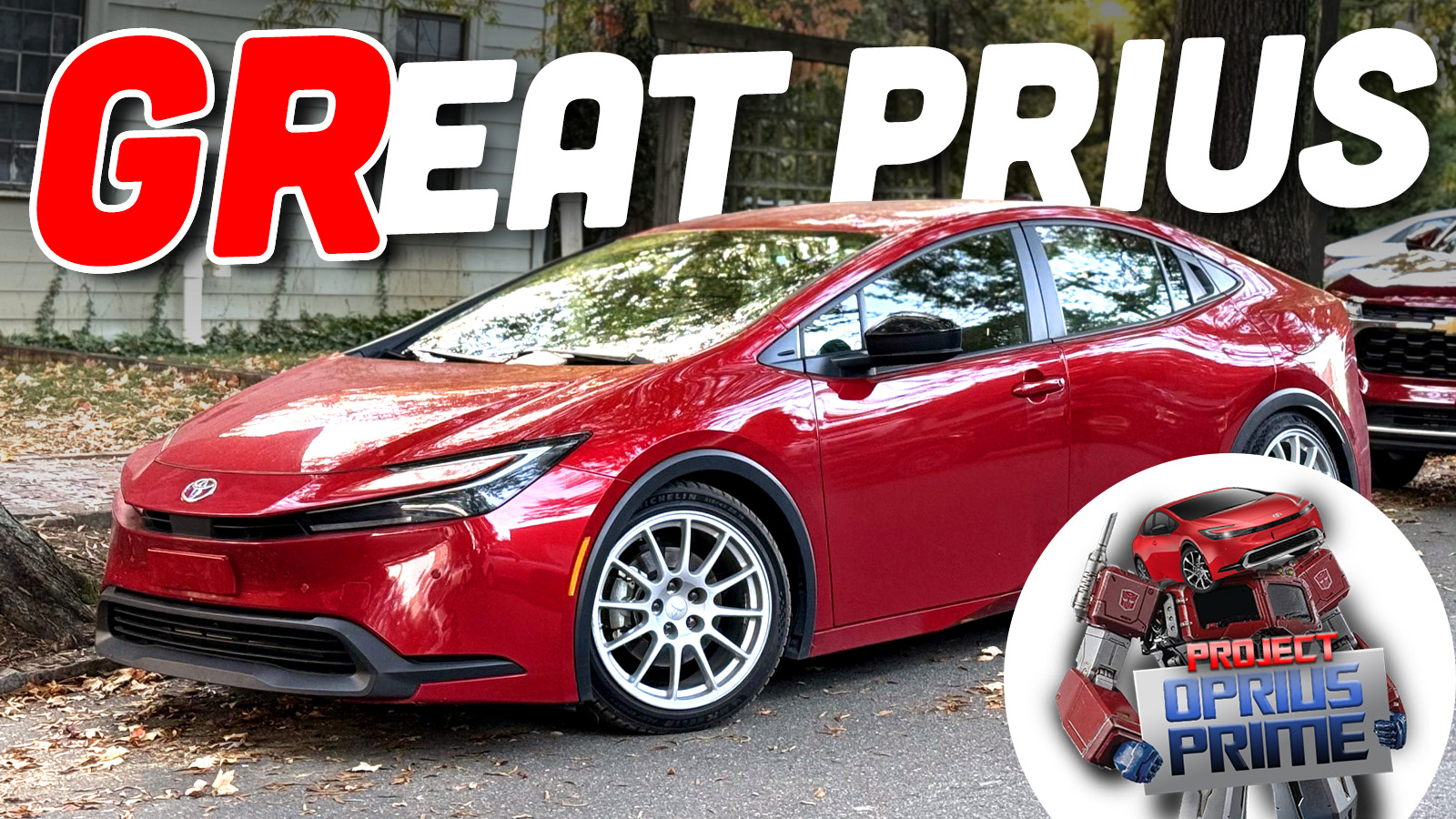







I love this build and the oem plus vibes.
Not sure there is an advantage to going OE GRC struts over aftermarket. Especially if changing spring it would make more sense to get something rebound matched to a spring. I have had a car with lowering springs from a platform shared car and it handled like crap. Much better now on stock springs.
Perhaps there is a Bilstein B8+spring combo or something (I think they call this B12)? These are usually tuned for the application so spring rates will have a good ride frequency front to back and dampers will match.
Also custom pads is pretty unhinged imo. Is it really worth the small weight advantage? There might be aftermarket 2 piece rotors or something in GRC size if that’s a concern.
Unfortunately not a whole lot available from the Prius other than going to a full coilover setup.
Custom pads aren’t actually that complex and Carbotech builds them fairly frequently for a bunch of applications.
I really wish we got a stopping distance check before and after of the new calipers and rotors. mostly because the braking is all done by wire electronically so im curious if the master cylinder even applies full force or what to the new calipers.
Bleeding brakes in a prius is so wierd. fot on the pedal .. nothing .. nothing … nothing and then half a quart of brake fluid comes gushing out all at once and 1 million psi.
very interesting that you are lowering your prius and i am about to lift mine. Mostly because i live in Alabama and the roads are absolute shit.
Not the exact same platform, but I’ve been doing some similar stuff to my 2022 Camry XSE Hybrid with results kind of like yours.
This Camry XSE comes with 19 inch wheels and 235mm wide all-seasons. I figured that I could reduce rotating mass while also increasing the amount of sidewall and contact patch available, so I replaced the stock wheels and tires with 17 x 8 inch RPF1’s with 255mm wide Continental Summer-only tires. This has had many benefits:
I honestly love how much it has improved the car. Because the Camry TRD exists, I’ve also been able to port over a few parts from it onto my XSE: the rear swaybar and underbody braces.
And here is something that I bet basically nobody has ever done to their Camry: I swapped out the wimpy donut spare for a (nearly) full-sized spare! Turns out that the Australian market Camry came with a full-sized spare as standard, and the trunk packaging pieces reflect those dimensions. So I bought those parts online and swapped the donut for a 17 x 7 RPF1 with a matching 225mm tire. Fits perfectly. The funny thing is that the donut is so heavy for being so small that the RPF1 spare only weighs 8 pounds more! Not bad!
Something I intend to do one day that perhaps you could do as well Bozi (depending on how far you want to go to reduce mass) is to replace the 12 volt lead-acid battery with something lighter. Yeah, the one in my trunk weighs 44 pounds, and all it is doing is energizing the hybrid system and sitting on standby. Antigravity sells a full size lithium-ion replacement that only weighs 14 pounds! The only real downside would be the cost ($1000), but otherwise it’s an easy way to shed another 30 pounds of dead weight from the car.
Keep up the good work, it’s always fun to figure out how to make a Toyota hybrid more efficient and more fun all at the same time.
i don’t think spending thousands of dollars to get a net 100 pound weight savings is really going to be “worth it” you also have to consider how taking weight out of the trunk will increase the front biased weight distribution of a front wheel drive car. also the 12v battery is not “sitting standby” it is powering your radio and your ECU and basically all of the systems inside the car. I would call the manufacturer of the battery about the upsides and downsides of installing a battery like that in a hybrid because it might not be a good fit in a hybrid. and also if it’s $1000 and only lasts 3 or 4 years that is really going to sting when it needs replaced.
Thank you for reminding me why I don’t usually post my thoughts about anything online: no matter how much I feel like my personal experience is relevant to the discussion and no matter how much I’m just exited to share how I did something fun and it worked well for me, there will always be someone out there ready to shit all over it by saying it’s pointless, doesn’t work, or isn’t worth it.
I could explain all the reasons to you why I think you are wrong or how you completely missed the point of what I was saying, but I don’t think you would care and it would be a waste of my time. Thank you for making my evening just a little but more discouraging. Goodbye.
I hope you are not too discouraged. I thought it was great information and the fact that products exist for people that are interested shows that we are not alone, no matter how misunderstood our modifications are. Keep doing what you want to do with cars. Also, I have a Miata too. A yacht of an NC. It’s fun, and actually not that heavy.
Hope you’re able to look past folks that bring you down, as I appreciated hearing about your mods and sensing the excitement you had for what you’re doing.
Please share again in the future, as happy readers often skip writing a comment saying they liked what they read.
I feel like that was an over reaction? I would not consider my comment “shitting all over” anything. I too love Toyota hybrids and love to discuss all of the possibilities and the pros and cons. But you can’t knowledge only the good without also mentioning the bad. I hope your evening improved.
Hey, I remember you! Weren’t you that depressed, angry dude who used to whine in the comments on Jalopnik? Wow, you haven’t changed a bit!
the cost gets back in cheaper tires for the exact same compound from the exact same brand, the tire is cheaper for the smaller diameter wheel. it’s about $40 per tire for Continental Extreme Contact Sport 02, and I’m sure others are similar. so call it $180 after you figure taxes for some reasonable tires. if you’re getting more extreme summer tires like some sport cup 2s? it’s a $100 difference from 19″ to 17″.
if you can sell your stock wheel/tires for $500, you don’t make money on the setup, but you also aren’t just throwing money into a pit either. after 2 tire changes, you are actually saving money, presuming you’re going for the extreme summer tires.
I think the wheels and tires are cool. but $1,000 for a lightweight 12v battery was mostly the concern.
That’s awesome. I really want to figure out a good spare tire solution that can fit underneath the minimal amount of space available under my rear hatch floor.
Cool that you were able to adapt some TRD stuff to fit.
reducing rotating mass is huge.
equally huge is where the rotating mass is located in relation to the axis.
look up angular acceleration, applied torque, and moment of inertia.
the ride will be absolutely more smooth. it’s questionable though, if you reduced 10lbs of weight per wheel, but there’s a lot of more weight for the added width of the wheel farther out from the center of the rotation, so it may be harder, or just as hard for the wheel to spin up, so maybe the 0-60 won’t be really much different.
not saying it’s a bad idea to put the smallest wheels you can fit over your brakes is a bad idea (it’s actually a great idea). just saying there’s always a trade-off to be aware of, especially if you increase the width of the wheel.
Yeah, I get what you mean: there is less weight overall but that weight is distributed differently because the wheels are wider. Actually, the wheels aren’t any wider though. Stock wheels on the Camry XSE are 19 x 8, these smaller ones are 17 x 8. So maybe the tire weight is distributed a bit further from the axis, but not by much.
At any rate, my priorities in going with smaller wheels and wider tires was (in order of importance): 1) increase grip due to increase in width, 2) increase ride comfort due to more sidewall, 3) spend less time cleaning my wheels (the stock ones were very fussy to keep clean), and 4) potentially gain other benefits due to a reduction in unsprung, rotating mass.
Anything I’ve gained due to #4 is a cherry on top for me. My butt dyno isn’t super accurate, but my guess is that my 0-60 improvement is negligible at best.
Funny you should mention the brakes thing, because the stock brakes used to look so small with 19 inch wheels, but the brakes fill up the 17 inch wheels quite well, making them look bigger than they actually are.
Of course it would be a bad financial investment, but I’ve thought before how certain places make semi-custom brake kits and how much more weight could be dropped with stock-sized 2 piece rotors and forged calipers. It seems like it would be a substantial amount.
even if you’re just looking from a financial perspective on how to afford extreme sport summer tires, as I noted to bassracerx, for Michelin pilot cup 2 tires, you’re able to save $100 per tire for the 17″ version as compared to the 19″ version. 2 tire changes, and you’ve almost paid for the set of wheels.
the newest generation of Prius was already the best it’s ever look, but the drop and wheels here look even better.
We all know modifications don’t add value to most cars BUT having most of these mods be made with OEM parts and no to little modification of the base car, I would think this would be appealing to the right buyer.
I’m just trying to justify a similar build in the future for myself.
As someone who just sold a heavily modified car last week… I doubt very much that you’ll find a buyer who will pay you even a penny more for these parts. Especially because the Venn intersection of Prius Shopper and Modding Enthusiast is probably only a handful of people in the US. And given that it sounds like it’s may take custom fabbed brake pads, that reinforces my opinion.
That said… I absolutely love the look of the new Prius, and am 100% on board with following this build.
edit: spelling is hard
Not sure I understand the effort in changing calipers, isn’t a lot of the braking still done by the hybrid system? I would think you’d be able to get away with smaller brakes than an ICE car because of that.
I might have mentioned it before, but a real cheap/easy mod that has huge benefits is just replacing your factory swaybar bushings with poly instead of rubber. Effectively makes them into larger/stiffer bars.
Has anyone hacked a new Prius ECU yet? I know on Insights you can change resistors to trick the system into giving way more wattage on the electric motor.
Love the idea of a performance prius, idk why Toyota doesn’t sell it already.
Regen will do a lot for braking but the main focus of swapping calipers is to drop around 4 pounds from each corner and make it look better.
I am intrigued by the electric motor mods. I haven’t heard of anyone hacking the ECUs but might have to read about what people have done with the Insights.
I was thinking the same thing, “Can’t regenerative braking do the job of upgraded foundation brakes?”
I think the reality is that in any EV or hybrid setup, there is a limit to how much energy the batteries and the system can absorb over a period of time, due to many factors, the most obvious being heat.
If you were on a race track, you would use up that capacity quickly, then you would have to rely on foundation brakes.
This is where the foundation brake upgrade really shines, as it’s greater ability to dissipate heat will allow the vehicle to maintain braking performance lap after lap.
Idk, my insight pulls braking power pretty decently until hte battery is full, at which point it abruptly STOPS, which has caused a tight butthole moment before.
Toyota has mastered the seamlessly blending of regen and friction, so that the driver has to pay a lot of attention to be able to tell who is doing the braking at any given moment.
Right, but once regen can’t regen anymore because batteries are 100%….
That makes perfect sense. The duty cycle of the brakes on a race track is much more severe than anything you can encounter on the street.
On the track, brake upgrades are pretty much a necessity.
I just recently moved back from Japan. And in Japan I’ve seen GR Prius’ going back to the 2019 model with the badging on the cars. Of course they could be modders like what your doing. Is the GR Prius actually a thing or people just doing performance upgrades?
I have seen a GR concept but not aware of any in production.
I wish I had taken pictures while I was there. If the owners did some modding then they went all out. From specialty seats with GR stitching some badging and fender flares. I saw more than one, so it must’ve been a thing there.
That’s really cool.
I know it’s been said many times before, but I still cannot get over how much better looking the current Prius is compared to previous versions. I haven’t driven the new one, but I gather it’s nicer to drive since moving to Toyota’s excellent TNGA platform too.
It wasn’t that long ago that base Priuses were buyable in the lower-$20Ks, but then again, an excellent Yaris iA (a Mazda 2 with an uglier nose) used to cost just $16Kish five years back. 🙁 Still, at $30K for a new Prius LE, it’s very appealing.
On my ’24 Prius Prime, I swapped out the stock 19″ wheels for 225/50R18’s mounted on 18×8 wheels. Stock combo was 47# each, the aftermarket combo was 44# each. It’s tough to accurately assess any mileage difference but my electric only range is typically over 40miles in mixed usage 50/50 city/hwy, with a big difference in ride comfort and handling. So, it’s possible to improve handling/ride without suffering a huge mpg hit.
That’s awesome.
I adore this series so much. I always look forward to these.
I’ll never own this car, nor ever do this upgrade, but I will read every bit of these articles with a smile on my face. Love the work. Keep the updates coming!
Appreciate that.
those stock wheels are SO ugly
They serve their purpose from the efficiency angle but I’ll take the weight penalty for something that looks a bit better.
And indeed. Both the ones you have used look so much better. I’ve seen an older Prius around here that has mini-lite replicas and they look pretty cool on that car.
Bozi, what is the reason not to use the 356mm GR rotors you already had, procuring instead that shorter bracket?
I didn’t want the added weight of the larger rotors. I share a little bit about that in the linked video above.
But do they all bolt up for those who want to have the improved braking with all OEM bits?
To properly mount them I would recommend using the 350phi caliper bracket.
Can you elaborate, please? I thought you had already mounted them with the original bracket and the only reason you did not follow through was that the 19′ forged wheels did barely clear. My understanding has been so far that the 350phi bracket for GR calipers is needed on cars with the TNGA-K platform (e.g. Camry) but not on TNGA-C.
I had mounted them with Yaris RC bracket but they were too close to the spokes of the wheel. I did not have a GRC rotor to test fitment with that combination.
My bad. I just looked again at the picture in the previous chapter and realized that that was indeed the stock 305mm rotor. At 8.1 kg those are admittedly much lighter that the stock GR rotor at 10.5 kg, but then you have many aftermarket options, like these Pumaspeed at 7.7 kg.
Will have to take a look at some of those options.
I went with Eibach Pro Line lowering springs on my GR-C. Not sure of the spring rate but I’ve used Eibach on like 4-5 previous cars so I felt confident.
I’ve looked at the Eibach kit along with Swift and RS-R and I do like that those are progressive.
Ranges from what I was able to find for the Eibach springs:
Front: Starting rate – 200lbs / Final rate – 330lbs
Rear: Starting rate – 228lbs / Final rate 370lbs
Glad to hear from you again, Bozi!
As an owner of a 2024 Prius Prime, I would like to subscribe to your newsletter.
I’ll try to do more frequent updates. What trim and color did you pick up?
Red XSE Premium.
My preference was for blue and SE, but I ended up with red and XSE Premium after a year long wait, as that was what the dealer could get. Not a lot of Prii Prime get shipped to the Midwest.
Welcome back, Bozi!
It’s no surprise that these parts should cross over with so little drama; the Corolla and Prius share a LOT of hardware under the skin, both using Toyota’s modular GA-C architecture. I’ve been reading about and watching other shadetrees upgrade their Prius with Corolla go-faster bits for a few years now. You are the benefactor of those cost-containing decisions that make intra-brand parts compatibility an unintended but welcome upside.
It’s great to be able to make use of some of the production efficiencies in order to make the Prius more fun to drive.
Great article, Bozi! I have a Gen 5 Prius XLE. Although I’m not much for wrenching (no garage), I’m up for more about your GR Prius Prime.
Cool to see that there are so many Prius owners reading here.
There are lots of us Prius-owning yahoos here, myself included! The Prius is dirt-cheap to fuel, insure, and maintain, so it maximizes leftover time and money for more fun/dumb automotive decisions.